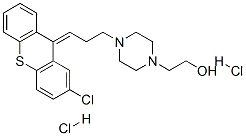| Identification | Back Directory | [Name]
(Z)-4-[3-(2-chloro-9H-thioxanthen-9-ylidene)propyl]piperazine-1-ethanol dihydrochloride | [CAS]
58045-23-1 | [Synonyms]
cis(Z)-Form dihydrochloride
Zuclopenthixol Dihydrochloride
Zuclopenthixol dihydrochloride salt
Zuclopenthixol Decanoate Impurity C as Dihydrochloride
Zuclopenthixol Decanoate EP Impurity C as Dihydrochloride
(Z)-4-[3-(2-chloro-9H-thioxanthen-9-ylidene)propyl]piperazine-1-ethanol dihydrochloride
Zuclopenthixol diHydrochlorideQ: What is
Zuclopenthixol diHydrochloride Q: What is the CAS Number of
Zuclopenthixol diHydrochloride Q: What is the storage condition of
Zuclopenthixol diHydrochloride Q: What are the applications of
Zuclopenthixol diHydrochloride | [EINECS(EC#)]
261-080-2 | [Molecular Formula]
C22H27Cl3N2OS | [MDL Number]
MFCD01702794 | [MOL File]
58045-23-1.mol | [Molecular Weight]
473.887 |
| Hazard Information | Back Directory | [Originator]
Zuclopenthixol
Hydrochloride,ZYF Pharm
Chemical | [Uses]
Zuclopenthixol ((Z)-Clopenthixol) dihydrochloride is a thioxanthene derivative which acts as a mixed dopamine D1/D2 receptor antagonist. Zuclopenthixol dihydrochloride is used in the study of schizophrenia[1][2][3]. | [Manufacturing Process]
288.0 g of 2-chloro-9-allylthiaxanthenol-(9), melting at 77-78°C, are prepared
by adding 2-chloro-thiaxanthone to an ether solution of allyl magnesium
bromide followed by hydrolysis.
The 2-chloro-9-allylthiaxanthenol-(9) is dissolved in 2 L of anhydrous ether,
whereafter 360.0 g triethylamine are added. While stirring and cooling, 150.0
g thionyl chloride dissolved in 500 ml ether are added gradually, allowing the
temperature to rise to a maximum of -10°C. After completion of addition, the ether solution is shaken 3 times with ice water, each time with 0.3 L,
whereafter it is dried with potassium carbonate. Thereafter, the ether is
evaporated in vacuum and the 2-chloro-9-(propene-3-ylidene-1)-thiaxanthene
formed is obtained as a light yellow syrup.
2 methods of producing of 2-chloro-9-[3'-(N'-2-hydroxyethylpiperazino-
N)propylidene]thiaxanthene from 2-chloro-9-(propene-3-ylidene-1)
thiaxanthene:
1). 27.0 g of 2-chloro-9-(propene-3-ylidene-1)thiaxanthene, are mixed with
50.0 g anhydrous piperazine and 10 ml absolute ethanol and the mixture is
heated for 12 h at 120°C under reflux. After cooling, the solidified reaction
mixture is treated with 500 ml of water and the mixture extracted with ether.
From the ether solution, the 2-chloro-9-(3'-N-piperazino)propylidene)
thiaxanthene formed is extracted with dilute hydrochloric acid and precipitated
as the base from the aqueous solution by rendering the solution alkaline. By
extraction with ether, drying of the ether solution with potassium carbonate
and evaporation of the ether, the free base 2-chloro-9-(3'-N-piperazino)
propylidene)thiaxanthene is obtained as a colorless oil in a yield of 21.0 g.
35.0 g of the base 2-chloro-9-(3'-N-piperazino)propylidene)thiaxanthene are
dissolved in 200 ml of methanol. 5.0 g ethylene oxide are added and the
mixture is left standing at room temperature for 3 h. Thereafter, the reaction
mixture is evaporated, dried and the 2-chloro-9-[3'-(N'-2-
hydroxyethylpiperazino-N)propylidene]thiaxanthene is obtained.
2). 27.0 g of 2-chloro-9-(propene-3-ylidene-1)thiaxanthene, are mixed with
50.0 g anhydrous N-2-hydroxyethylpiperazine and 10 ml absolute ethanol and
the mixture is heated for 12 h at 120°C under reflux. After cooling, the
solidified reaction mixture is treated with 500 ml of water and the mixture
extracted with chloroform. From the chloroform solution, the 2-chloro-9-[3'-
(N'-2-hydroxyethylpiperazino-N)-propylidene]thiaxanthene formed is extracted
with dilute hydrochloric acid and precipitated as the base from the aqueous
solution by rendering the solution alkaline. By extraction with chloroform,
drying of the organic solution with potassium carbonate and evaporation of
the chloroform, the base 2-chloro-9-[3'-(N'-2-hydroxyethylpiperazino-
N)propylidene]thiaxanthene is obtained as colorless syrup.
By dissolving the base in petrol and leaving the solution to stand the trans
form crystallize out as a white crystalline substance, from the mother liquor
from the trans base, the corresponding cis base can be obtained as a white
crystalline substance.
In practice it is usually used as dihydrochloride. | [Therapeutic Function]
Neuroleptic, Antipsychotic | [in vivo]
After acute treatment, Zuclopenthixol (0.2 and 0.4 mg/kg)-treated animals exhibit ethopharmacological profiles characterized by a decrease in offensive behaviors without impairment of motor activity (0.2 mg/kg). In contrast, the antiaggressive action of the highest dose used (0.4 mg/kg) is accompanied by a marked increase of immobility. After subchronic treatment, no tolerance to Zuclopenthixol antiaggressive or motor activity is observed[1].
Administration of Zuclopenthixol (0.7 and 1.4 mg/kg) significantly elevate MDA level compared to respective controls. Nevertheless, there is no difference between the two dose levels with respect to their effect on rat brain MDA level. Post hoc pairwise comparisons between the means of groups (n=12) receiving different dose levels of Zuclopenthixol reveal that administration of 1.4 mg/kg of Zuclopenthixol significantly reduces GSH level compared to both vehicle-treated and Zuclopenthixol (0.7 mg/kg)-treated animals (P<0.001). Nevertheless, the lower dose of the drug does not affect rat brain GSH level. Animals receiving 0.7 or 1.4 mg/kg of Zuclopenthixol exhibits significantly higher GSH levels than SCO treated animals. Administration of 0.7 mg/kg of Zuclopenthixol significantly elevated GSHPx activity compared to vehicle treated animals[2]. | [IC 50]
D2 Receptor | [References]
[1] Khalifa AE, et al. Pro-oxidant activity of zuclopenthixol in vivo: differential effect of the drug on brain oxidative status of scopolamine-treated rats. Hum Exp Toxicol. 2004 Aug;23(9):439-45. DOI:10.1191/0960327104ht470oa
[2] Manzaneque JM, et al. An ethopharmacological assessment of the effects of zuclopenthixol on agonistic interactions in male mice. Methods Find Exp Clin Pharmacol. 1999 Jan-Feb;21(1):11-5. DOI:10.1358/mf.1999.21.1.527012
[3] Bryan EJ, et al. Zuclopenthixol dihydrochloride for schizophrenia. Cochrane Database Syst Rev. 2017 Nov 16;11(11):CD005474. DOI:10.1002/14651858.CD005474.pub2 |
|
|






